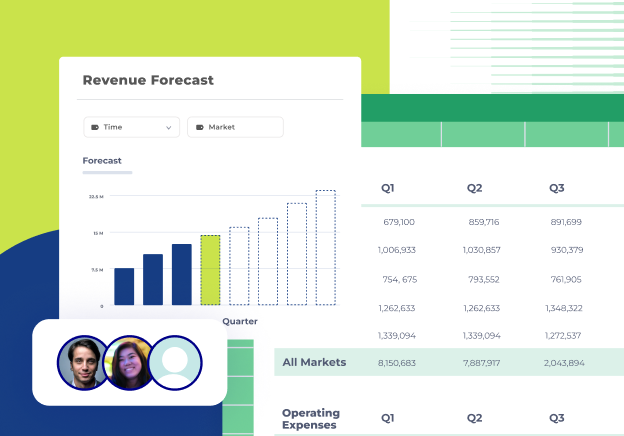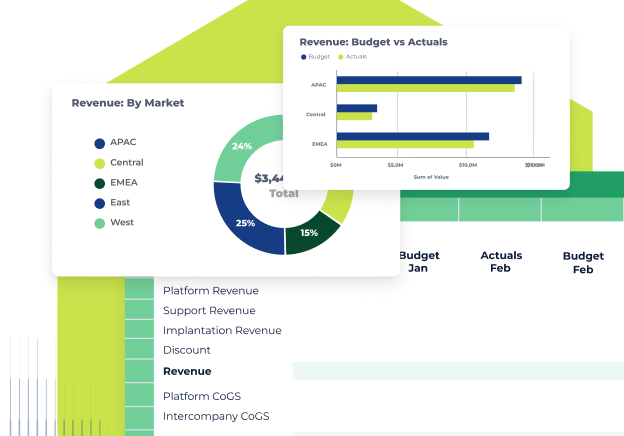What is a financial strategy?
A financial strategy is a high-level plan that guides how a company manages its financial resources to achieve business objectives. It determines how cash flow, investments, expenses, and revenue generation align with long-term goals. The CFO is responsible for developing and executing this strategy, ensuring financial decisions support corporate growth and resilience.
A strong financial strategy provides a roadmap for sustainable growth by optimizing capital structure planning, improving cost efficiencies, and identifying opportunities for expansion. Truly strategic financial planning enables CFOs to anticipate challenges, allocate resources effectively, and drive long-term value.
How strategic is your finance team? Take this free Strategic Finance Assessment to see how well your finance function supports strategic growth.
Types of financial strategies
CFOs need a clear and structured approach to align strategic finance with broader business objectives while maintaining adaptability in a dynamic environment.
- Capital allocation strategies focus on distributing resources such as cash, equity, and debt across operational needs, investments, and growth opportunities. Allocating funds effectively strengthens business performance and ensures the organization can scale while maintaining financial stability.
- Risk management strategies aim to identify and address potential financial threats, including market volatility, credit exposure, and currency fluctuations. Organizations can implement tools like hedging, diversification, and scenario analyses to safeguard long-term profitability.
- Investment strategies prioritize initiatives such as capital expenditures, mergers, acquisitions, and innovation projects. Finance leaders evaluate the potential return on investment and strategic alignment of each opportunity to maximize value creation.
- Debt management strategies balance the use of leverage with maintaining financial flexibility. Finance managers focus on optimizing the mix of short-term and long-term debt, managing interest rates, and identifying refinancing opportunities to reduce costs.
- Profitability strategies center on improving margins and controlling costs while driving revenue growth. CFOs analyze operational efficiency, pricing models, and cost structures to ensure sustainable profitability without compromising competitiveness.
- Liquidity strategies ensure the organization maintains sufficient cash flow for operational needs and strategic investments. Finance leaders focus on managing working capital, optimizing payment terms, and securing access to funding sources to avoid disruptions.
- Shareholder return strategies guide decisions surrounding dividends and share buybacks. CFOs evaluate capital requirements, market conditions, and investor expectations to balance reinvestment with delivering value to shareholders.
Each financial strategy requires alignment with the company’s long-term goals, industry trends, and market conditions. Finance teams can monitor performance metrics and reassess priorities to ensure that every decision supports sustainable growth and financial resilience.

How to build an effective financial strategy for business success
A CFO’s financial planning, analysis, and budgeting aligns financial decisions with business goals while ensuring long-term growth and stability. A structured process equips CFOs to make informed decisions, allocate resources efficiently, and adapt to economic shifts.
1. Evaluate the company’s current financial position
This involves setting out financial goals and devising plans to achieve them. Understanding the company’s financial standing involves assessing liquidity, capital structure, and cash flow patterns. This step establishes a foundation for identifying strengths, challenges, and areas requiring improvement.
Regular cash flow forecasting based on current and projected financial activities provides insights into financial stability and supports strategic planning. Analyzing revenue drivers, expenditure trends, and market conditions enables the CFO to anticipate challenges and adjust accordingly. Maintaining a clear view of financial health ensures that the organization remains agile and positioned for future opportunities.
2. Establish financial goals and metrics
Defining clear objectives ensures alignment between corporate strategy and financial execution. CFOs identify key performance indicators (KPIs) that measure profitability, operational efficiency, and liquidity. Ensure you prioritize monitoring KPIs most relevant to your business operations to focus your finance teams’ effort on what really matters.
Metrics such as gross margin, return on investment (ROI), and cash conversion cycles offer actionable insights into performance. Regularly tracking these indicators helps pinpoint inefficiencies and guide decisions that drive sustainable growth.
3. Conduct market analysis
Understanding market dynamics is essential for building a financial strategy that’s both proactive and resilient. It’s not just about managing numbers—it’s about extending your role beyond internal financial management to include external factors that directly impact business performance.
By analyzing industry trends, customer behaviors, competitor strategies, and broader economic indicators, CFOs gain the insight needed to steer the organization through uncertainty and toward opportunity. This knowledge helps identify pricing pressures, shifts in customer demand, and emerging threats for stronger forecasting and sharper strategic direction.
Here’s how to deepen your market analysis approach:
- Conduct regular market research: Stay current with industry reports, economic updates, and competitor news. Benchmarking studies, investor presentations, and market analyses can highlight shifts that may affect your financial forecasts. External partners—like your accounting firm, bank, or consultants—can also provide invaluable insights.
- Build relationships with market experts: Networking with industry analysts and other CFOs can give you perspectives you won’t find in reports. These conversations often reveal how peers are budgeting, hiring, or preparing for economic shifts, which can validate or challenge your own assumptions.
- Educate your team and leadership: Don’t keep these insights to yourself. Help your FP&A teams and senior leaders understand how external market shifts can influence internal decisions. This turns your finance function into a strategic partner for every department.
Grasping market dynamics elevates your role from financial steward to business strategist. It positions you to help the company navigate uncertainty, capitalize on emerging opportunities, and avoid costly missteps—all of which are critical for sustainable success.
4. Set up thorough analysis and reporting
Think of this phase as your company’s dashboard—it shows how fast you're moving, how much fuel you have, and whether there are warning lights to address. But the real value isn’t just in the data—it’s in understanding what the data means and what to do next.
Effective reporting is more than data delivery—it’s storytelling. It shows how revenue, expenses, and cash flow stack up not just in isolation, but in the context of your business goals. Are you exceeding expectations, falling behind, or operating within range? Like a speedometer compared to a speed limit, financial reports are only meaningful when benchmarked against your strategic objectives.
But reporting is just the starting point. Analysis digs deeper. It asks: Why are sales up this quarter? How can we replicate that success? Why did costs spike in one department? One method to surface insights is the ‘5 whys’ technique—an approach that challenges teams to ask “Why?” repeatedly to uncover the root causes of financial outcomes.
5. Monitor and revise your financial strategy
A financial strategy evolves in response to changing conditions. CFOs regularly assess performance and adjust decisions to align with business objectives. Benchmarking against industry peers and analyzing trends ensures businesses stay competitive. Frequent reviews highlight deviations from targets and create opportunities for course correction. This ensures the company remains competitive, resilient, and well-positioned for growth.
6. Create your financial plan
Once the financial strategy is clearly defined, financial planning puts it into action. While strategy sets direction, planning builds the roadmap. Effective planning begins with establishing financial targets that prioritize growth, profitability, and operational efficiency.
Then, your FP&A teams can take the lead. They translate high-level goals into executable financial plans, ensuring resources are allocated effectively and departments are aligned with strategic objectives. Teams should also integrate scenario modeling into their strategies to evaluate potential outcomes under varied conditions.
Stress-testing assumptions allows finance leaders to identify vulnerabilities and implement contingency plans—ensuring resilience and adaptability in shifting markets.
Best practices for implementing a strong financial strategy
Developing a financial strategy requires more than just planning—it demands actionable steps and a focus on execution. CFOs must combine data accuracy, technology-driven processes, adaptability, and effective communication to ensure alignment with business objectives while maintaining flexibility to respond to changes.
Create a foundation with data integrity
Accurate and reliable financial data serves as the cornerstone of effective decision-making. Errors or inconsistencies in data can lead to miscalculations, compliance risks, and misaligned strategies.
Regular audits and standardized processes improve accuracy, while tools designed for real-time data validation enhance transparency. Comprehensive data integrity and governance ensures that all financial insights are grounded in facts so teams can make well-informed decisions that drive business success.
Embrace adaptability and continuous learning
The pace of change in financial operations requires a mindset ready to adjust strategies as conditions evolve. View change as opportunities to improve, not challenges. CFOs who stay informed about market trends, regulatory updates, and emerging technologies can better position their organizations for long-term success.
Provide professional development opportunities, such as financial modeling courses or scenario analysis workshops, to equip your finance teams with the tools to anticipate shifts and respond effectively. Regular reviews of financial strategies ensure they remain relevant and aligned with business goals, even in changing market conditions.
Prioritize communication and relationship-building
Strategic finance leadership goes beyond data interpretation—it requires influence. As a CFO, your ability to communicate financial insights clearly and persuasively is just as important as the numbers themselves.
Strong communication builds trust across the organization. It enables alignment with executive leadership and department heads and helps everyone understand how financial plans tie into operational goals. Develop presentation skills that resonate with both financial and non-financial stakeholders. Frame your insights in a way that supports action and demonstrates that you understand the broader business context.
To enhance collaboration:
- Align goals with OKRs (Objectives and Key Results): Tie financial targets to company-wide initiatives.
- Engage with department leaders: Understand their pain points, priorities, and how finance can support them.
- Communicate with clarity and empathy: Deliver data in formats that empower others to make better decisions, not just absorb information.
Plan for both risks and opportunities
Being proactive about risks and opportunities is a defining trait of effective CFOs. It’s not just about protecting the downside—it’s about maximizing upside potential. Strategic finance leaders continuously scan for vulnerabilities while identifying areas where the business can grow or innovate.
To stay ahead, make sure your finance teams:
- Evaluate potential financial disruptions, such as supply chain issues, regulatory changes, or macroeconomic shifts.
- Incorporate sensitivity analysis to understand which variables most impact your financial position.
- Look for untapped markets, product innovations, or operational efficiencies.
- Consider how trends in consumer behavior, technology, or global demand might create openings for new investments or business models.
- Use flexible financial models and scenario planning to simulate different outcomes and assess your company’s exposure.
Use automated finance software
Automation allows finance teams to streamline operations and eliminate inefficiencies in processes such as budgeting, forecasting, and reporting. Deploying automated financial tools accelerates workflows, reduces manual errors, and enhances productivity.
Automated finance software can generate AI-proposed forecasts that finance teams can use as a starting point, automatically highlight variances, and flag potential errors or inconsistencies in data. Teams gain more time to focus on analysis and strategy, allowing the finance function to take on a more proactive role within the organization.
Drive success using the right financial strategies
A well-crafted financial strategy empowers CFOs to allocate resources effectively, mitigate risks, and unlock long-term value. Every decision should align with corporate objectives, reinforcing stability and fostering sustainable growth.
Get started by evaluating your finance team’s strategic readiness with this Free Strategic Finance Assessment.



.png)









.png)

![How to develop financial strategies for business success [2025]](https://www.cubesoftware.com/hubfs/EBook%20Cover%20(31).png)


.png)
.png)
.png)